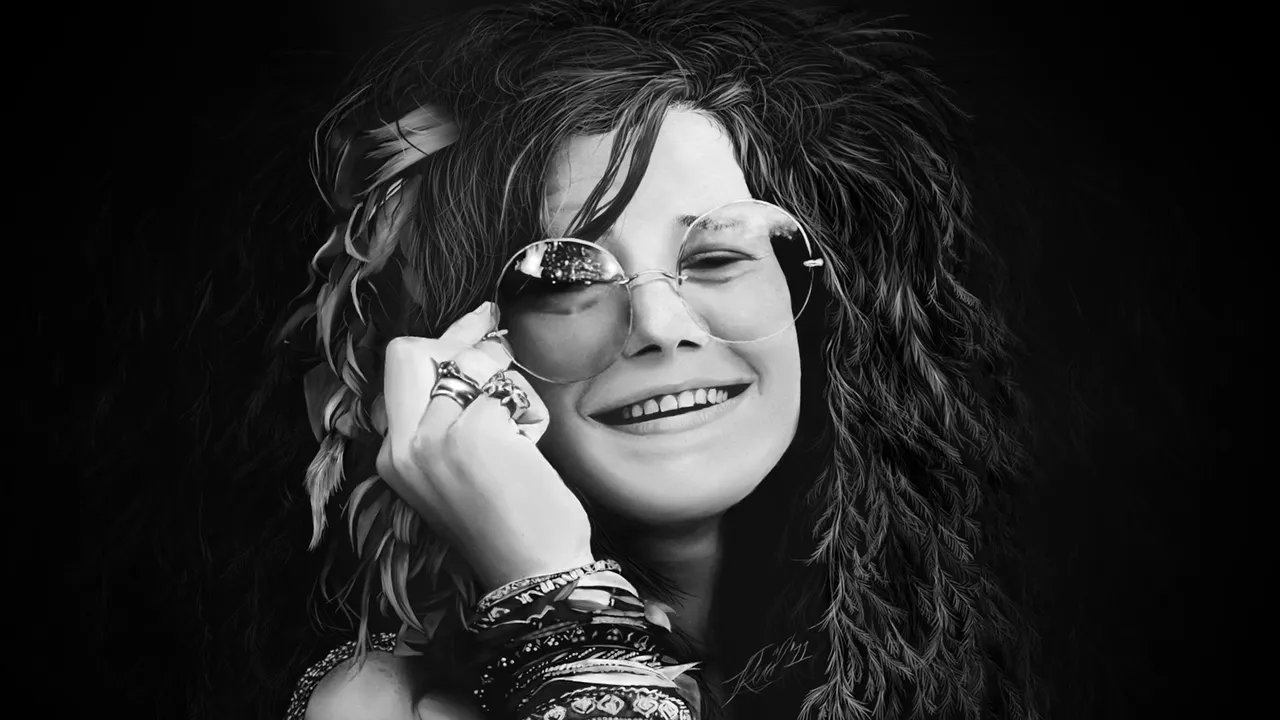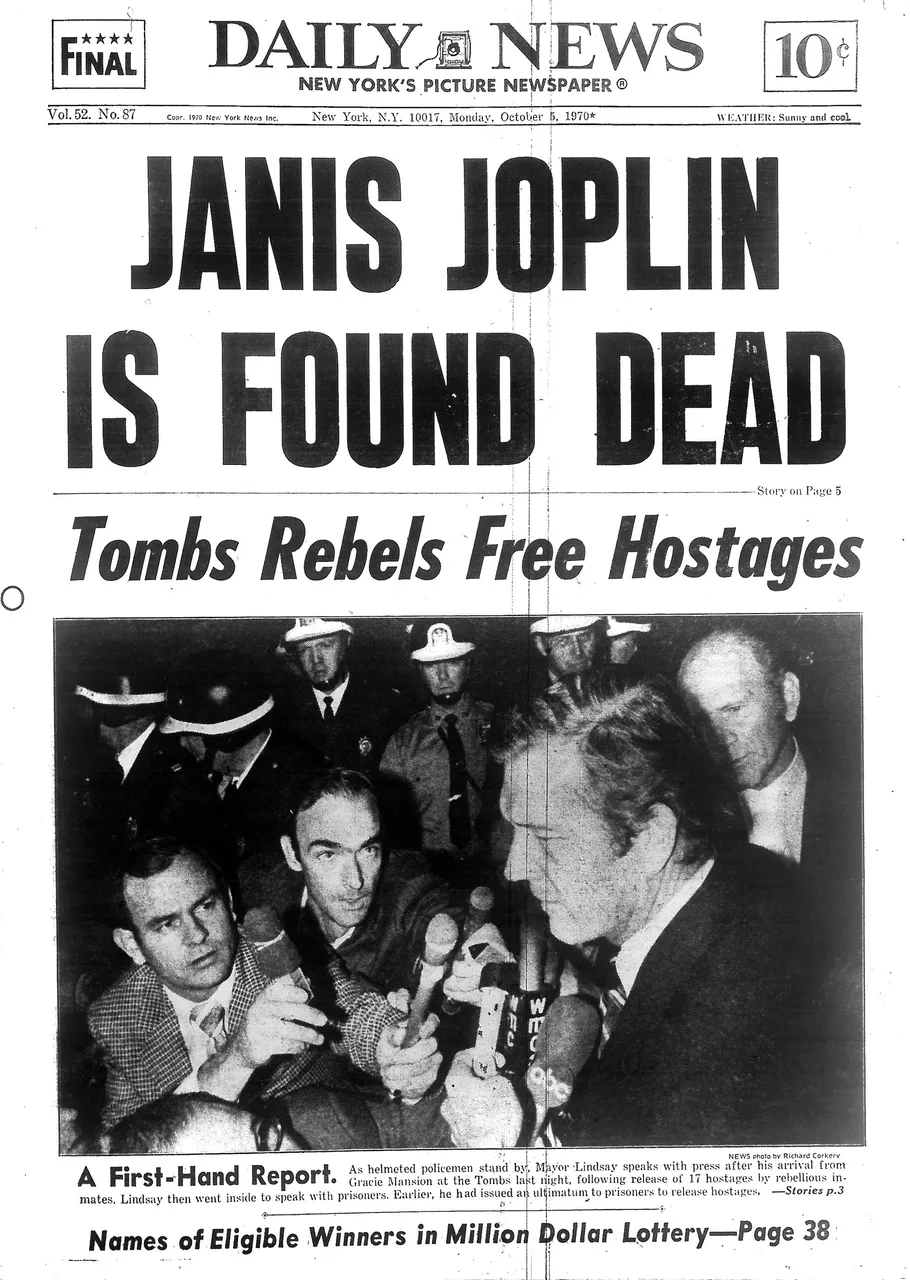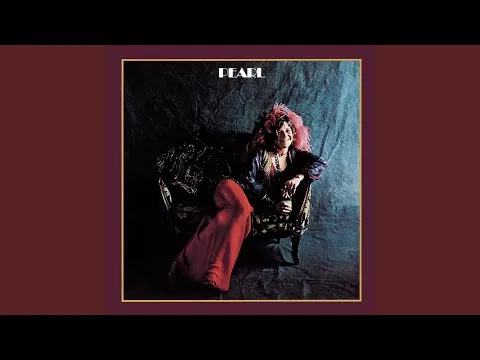Como parte de sus actividades para recaudar fondos, a la fraternidad Alfa Pi Omega de la Universidad de Texas, en Austin, le pareció “gracioso” y muy “creativo” organizar la elección de “El Hombre más feo del Campus”, y más divertido aún le pareció aceptar la postulación (hecha bajo anonimato) de una chica que gustaba de ir descalza por el lugar, vestía de jeans y cantaba “música de negros” cuando le provocaba. La universidad se empapeló con fotos de la joven bajo las cuales se leía: “Vota al hombre más feo”. El año era 1962 y la chica era Janis Joplin, tenía 19 años.
Aquella pesada “broma estudiantil”, reflejo de una sociedad ofensivamente miedosa en la que Janis nunca encajó, devolvió a la futura rockstar las imágenes del acoso sufrido por su apariencia y excentricismo durante la secundaria, en la muy cristiana Port Arthur, Texas. Lloró. Lloró recordando no encajar, lloró añorando su refugio en las voces de Bessie Smith, Ma Rainey o Big Mama Thornton, lloró tanto como pudo con la esperanza de no tener que llorar más. Sólo le quedaba poner tierra por medio entre ella y aquel lugar hostil, conservador, ultra religioso, que se resistía a la integración racial y con el Ku Klux Klan como presencia vigente y de peso en la comunidad. Así que, sin mirar atrás, enfiló proa a San Francisco, "solo para estar lejos de Texas, porque mi cabeza estaba en un lugar muy diferente", según dijo en enero de 1963 viviendo en Playa Norte.
As part of its fundraising activities, the Alpha Pi Omega fraternity at the University of Texas in Austin found it "funny" and very "creative" to organize the election of "The Ugliest Man on Campus", and even funnier to accept the nomination (made under anonymity) of a girl who liked to walk around barefoot, wore jeans and sang "negro music" when provoked. The university was papered with photos of the girl under which read: "Vote for the ugliest man". The year was 1962 and the girl was Janis Joplin, she was 19 years old.
That heavy "student prank", a reflection of an offensively fearful society in which Janis never fit, brought back to the future rockstar the images of the harassment she suffered for her appearance and eccentricity during high school, in the very Christian Port Arthur, Texas. She cried. She cried remembering not fitting in, she cried longing for her refuge in the voices of Bessie Smith, Ma Rainey or Big Mama Thornton, she cried as much as she could in the hope that she wouldn't have to cry anymore. All that was left for her to do was to put some ground between her and that hostile, conservative, ultra-religious place, which resisted racial integration and with the Ku Klux Klan as a current and powerful presence in the community. So, without looking back, she set sail for San Francisco, "just to be away from Texas, because my head was in a very different place," as she said in January 1963, living in North Beach.
No era la primera vez que Janis intentaba escapar a San Francisco. De hecho, su paso por la Universidad de Texas, fue parte de un sincero intento de reconciliación familiar, tras una primera aventura en la cuna de la Revolución Hippie. Pero esta vez sería diferente. En esta ocasión haría de su voz la llave que abriría todas las puertas.
Tras un par de años de juergas, presentaciones ocasionales en bares y fracasos sentimentales, Joplin se unió la banda Big Brother and the Holding Company en 1966, con quienes saltaría a la fama tras su presentación en el mítico Festival de Monterrey de 1967, donde alternó con los grandes de la época como The Mamas and The Papas, The Who, Jefferson Airplane, y Jimi Hendrix, entre otros. En esa ocasión, la joven cantante de 23 años dejó a todos boquiabiertos con su versión de Ball and Chain, el clásico del blues de Big Mama Thornton.
Pronto se hizo evidente que la voz de Janis le quedaba grande a la banda y, tras un segundo disco con los Big Brother (Cheap Thrills, 1968), la ya consagrada superestrella acepta grabar como solista, lanzando en 1969 I Got Dem Ol' Kozmic Blues Again Mama!, junto a la "Kozmic Blues Band". En agosto de ese mismo año se presentó en el histórico Festival de Woodstock y tuvo que hacer bises a sus versiones de Ball and Chain y Piece of My Heart. Con apenas tres años de carrera y solo tres discos en su haber, La Bruja Cósmica (como empezaron a llamarla) era la Reina indiscutible del Rock. El domino de su portentosa voz y el desenfreno de su puesta en escena eran una paradójica combinación difícil de resistir. El siguiente video, extracto de una presentación en Alemania, en abril del 69, ilustra muy bien de lo que hablamos.
It wasn't the first time Janis had tried to escape to San Francisco. In fact, her time at the University of Texas, was part of a sincere attempt at family reconciliation, after a first adventure in the cradle of the Hippie Revolution. But this time it would be different. This time he would make his voice the key that would open all the doors.
After a couple of years of binges, occasional presentations in bars and sentimental failures, Joplin joined the band Big Brother and the Holding Company in 1966, with whom she would jump to fame after her presentation at the mythical Monterrey Festival of 1967, where she alternated with the greats of the time such as The Mamas and The Papas, The Who, Jefferson Airplane, and Jimi Hendrix, among others. On that occasion, the 23-year-old singer blew everyone away with her version of Ball and Chain, the blues classic by Big Mama Thornton.
It soon became evident that Janis' voice was too big for the band and, after a second album with Big Brother (Cheap Thrills, 1968), the already consecrated superstar agreed to record as a soloist, releasing in 1969 I Got Dem Ol' Kozmic Blues Again Mama! with the "Kozmic Blues Band". In August of that same year he performed at the historic Woodstock Festival and had to do encores to his acclaimed versions of Ball and Chain and Piece of My Heart. With only three years of career and only three albums to her credit, The Cosmic Witch (as they began to call her) was the undisputed Queen of Rock. The dominance of her portentous voice and the wildness of her staging were a paradoxical combination hard to resist. The following video, an extract from a performance in Germany in April '69, illustrates very well what we are talking about.
Janis cerró la década de los 60 separándose de la Kozmic Blues Band, con dos fechas agotadas en el Madison Square Garden, el 19 y 20 de diciembre. En febrero de 1970 viajó a Río de Janeiro para disfrutar el carnaval. Allí conoció y se enamoró de David Niehouse, con quien viajó por unos meses, a lo beatniks, por la selva brasilera.
Luego regresó a San Francisco y al poco tiempo aceptó la invitación de iniciar ensayos con una nueva banda: Full Tilt Boogie Band. En el verano del 70 participó con ellos, junto a The Grateful Dead, Buddy Guy y The Band, en el Festival Express. Luego se trasladó a Los Ángeles, para iniciar, en el estudio Sunset Sound, las sesiones de grabación de Pearl, su cuarto álbum. Janis, según la mayoría, estaba feliz. Durante su estancia en Brasil había conseguido desengancharse de la heroína, aunque no del alcohol. Al menos eso creyeron todos.
El 3 de octubre había sido un buen día. Se hizo el registro instrumental de la canción Buried alive in the blues. Al terminar de grabar los instrumentos, alrededor de las 11 de la noche, una Janis satisfecha se retiró a su habitación en el Landmark Motor, un motel ubicado junto al Hollywood Boulevard, con el compromiso de grabar la voz al día siguiente.
El 4 de octubre la cantante no se presentó, por lo que su Manager de Ruta decidió ir a buscarla. Cuando entró en la habitación 105 del motel, encontró el cadáver de la primera gran diva de la historia rock, imagen y voz de la mujer liberada de los años 60, un solitaria genio del canto que lo único que no logró en la vida fue encajar entre sus asustados semejantes. Dieciséis días antes, habían hallado muerto, también víctima de una sobredosis, a Jimmy Hendrix, con quien llegó a intimar ocasionalmente. Ambos tenían 27 años.
Janis closed the decade of the 60's separating from the Kozmic Blues Band, with two sold-out dates at Madison Square Garden, on December 19 and 20. In February 1970 she traveled to Rio de Janeiro to enjoy the carnival. There he met and fell in love with David Niehouse, with whom she traveled for a few months, beatnik-style, through the Brazilian jungle.
She then returned to San Francisco and soon after accepted an invitation to start rehearsals with a new band: Full Tilt Boogie Band. In the summer of 1970 she participated with them, along with The Grateful Dead, Buddy Guy and The Band, in the Express Festival. Then she moved to Los Angeles, to start, at Sunset Sound studio, the recording sessions for Pearl, her fourth album. Janis, according to most, was happy. During her stay in Brazil she had managed to get off heroin, but not alcohol. At least that's what everyone believed.
October 3 had been a good day. The instrumental tracks of Buried alive in the blues was recorded. At the end of instrument recording, around 11 p.m., a satisfied Janis retired to her room at the Landmark Motor, a motel located next to Hollywood Boulevard, with a commitment to record the vocals the next day.
On October 4, the singer didn't show up, so her Route Manager decided to go looking for her. When she entered room 105 of the motel, she found the corpse of the first great diva in rock history, image and voice of the liberated woman of the 60's, a lonely singing genius that the only thing she failed to achieve in life was to fit in among her frightened peers. Sixteen days earlier, Jimmy Hendrix, with whom she was occasionally intimate, had been found dead, also a victim of an overdose. Both were 27 years old.
El legado de Janis Joplin trasciende sus cuatros discos de estudio y las numerosas grabaciones en vivo donde desbordaba energía y se podía apreciar mejor su fuerza y talento. Su legado se puede apreciar en las voces rockeras femeninas que le siguieron, pues ella rompió el celofán de un género musical hasta entonces dominado exclusivamente por los hombres. Pero también se puede apreciar en el estilo vocal y estético de cantantes masculinos posteriores, como Robert Plant, Steven Tyler o Axel Roses.
Si se trata de números, Janis Joplin sigue entre los artistas con mayores ventas de los Estados Unidos, con 15,5 millones de copias vendidas solo en su país. En 2003, Pearl, su disco póstumo, se colocó en el lugar 122 de los 500 álbumes más vendidos de todos los tiempos, mientras que Cheap Thrills alcanzó, ese mismo año, el puesto 338 de la lista.
Janis Joplin, a costa de sí misma, quiso construir un personaje que transgrediera las barreras que alguna vez quisieron imponerle a su verdadero amor, el único con el que fue realmente libre y en el que sorteó una mastodóntica soledad que no pudo curar en los brazos de amantes, amigos o familia: cantar. “Fue una pionera. E hizo sacrificios para asumir riesgos que allanaron el camino para que las artistas mujeres ganaran presencia en la industria de la música y para que no se ajustaran a las demandas que imponía una sociedad patriarcal”, afirma Holly George-Warren, autora del libro Janis Joplin. La biografía definitiva de la legendaria reina del rock.
Janis Joplin's legacy transcends her four studio albums and the numerous live recordings where her energy overflowed and her strength and talent could be better appreciated. Her legacy can be seen in the female rock voices that followed her, as she broke the cellophane of a musical genre until then dominated exclusively by men. But it can also be seen in the vocal and aesthetic style of later male singers, such as Robert Plant, Steven Tyler or Axel Roses.
When it comes to numbers, Janis Joplin is still among the best-selling artists in the United States, with 15.5 million copies sold only in her home country. In 2003, Pearl, her posthumous album, ranked 122nd on the 500 best-selling albums of all time, while Cheap Thrills reached, that same year, the 338th place on the list.
Janis Joplin, at the expense of herself, wanted to build a character that transgressed the barriers that once wanted to impose on her true love, the only one with which she was truly free and in which she circumvented a mastodonic loneliness that she could not cure in the arms of lovers, friends or family: singing. "She was a pioneer. And she made sacrifices to take risks that paved the way for female artists to gain a presence in the music industry and to not conform to the demands imposed by a patriarchal society," says Holly George-Warren, author of the book Janis Joplin. The definitive biography of the legendary queen of rock.
 Fuente
FuenteDespués de Janis el rock ha contado con grandes voces femeninas. Pero ninguna con la facultad de transgredir barreras raciales, de género y sexuales, mezclando en su justa medida la tradición de las grandes voces que le precedieron con las nuevas tendencias, en un potente y peligroso coctel que, con solo oírlo, nos invita a ser libres. “Cuando ella cantaba oías la libertad”, llegó a decir el ingeniero de sonido Jackie Mills.
Cerraré este artículo con la última grabación que realizó Janis, el 1 de octubre de 1970, durante las sesiones para Pearl. Se trata de Mercedes Benz, un tema de su autoría, cuya primera frase (“Oh Dios, ¿no me comprarás un Mercedes Benz?”) es del poeta de la Generación Beat Michael McClure. Es la típica grabación relajada, medio en broma medio en serio, que jamás habría visto la luz a no ser que, tras su sorpresiva muerte, la banda y los productores decidieran incluirlo en su honor como perfecto cierre para el álbum: con una carcajada.
After Janis, rock has had great female voices. But none with the power to transgress racial, gender and sexual barriers, mixing the tradition of the great voices that preceded her with new trends in a potent and dangerous cocktail that, just hearing it, invites us to be free. "When she sang you heard freedom," said sound engineer Jackie Mills.
I will close this article with the last recording Janis made, on October 1, 1970, during the sessions for Pearl. It's Mercedes Benz, a song she wrote, whose first line ("Oh God, won't you buy me a Mercedes Benz?") is by Beat Generation poet Michael McClure. It's the typical laid-back, half-joking, half-serious recording that would never have seen the light of day unless, after her surprise death, the band and producers decided to include it in her honor as the perfect album closer: with a laugh.
Si quieres saber más sobre Janis Joplin y su música, te dejo algunas referencias más abajo. ¡Hasta la próxima Hiveanos!... Y que viva la música.
If you want to know more about Janis Joplin and her music, here are some references below. See you next time Hiveanos!... And long live the music.
EL ESPÍRITU DE JANIS: LANDMARK HOTEL, L.A. (escaramuza.com)
50 años sin Janis Joplin: crónica de un grito de auxilio que nadie escuchó (El País)
Janis Joplin: las 5 mejores canciones del primer icono femenino del rock (Público.es)
JANIS JOPLIN SE DESPIDIÓ CANTANDO ‘MERCEDES BENZ’ Y FELICITANDO A JOHN LENNON POR SU 30º CUMPLEAÑOS
Pearl (1970): Playlist del album completo en youtube





